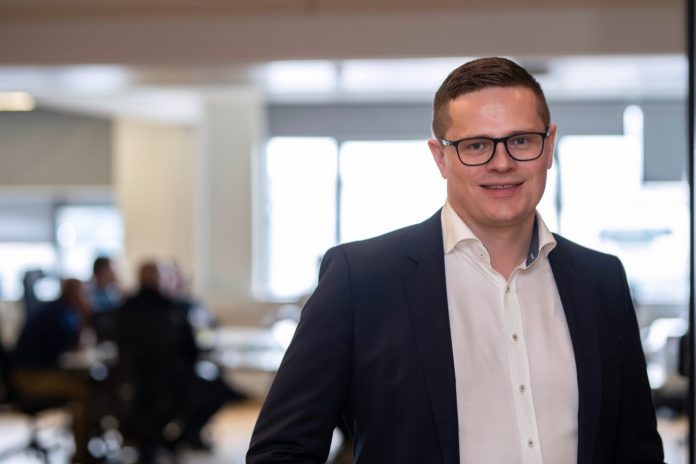As more and more people move online, cases of financial crime are increasing. This is subsequently increasing the opportunity for money laundering to be conducted. As industry players continue to search for the silver bullet to tackle financial crime, RegTech firm Lucinity is focused on helping to clean up the financial world.
Founded in 2018, Lucinity helps financial services compliance teams shed light on cases of money laundering through a surveillance cloud solution that uses Human AI, AI technology designed to empower human analysts, to improve productivity and bolster regulatory compliance. Lucinity operates globally, with teams in Reykjavík, London, and New York.
The company was founded by Gudmundur Kristjansson (GK), who also serves as its CEO. Prior to founding Lucinity, he spent time in the MedTech and EdTech industries and, through what he describes as a series of coincidences and decisions, ended up in the compliance technical industry, where he really started to think about ‘how to change the behaviour of traders’.
The long-term goal of Lucinity – as well as its mantra – is to ‘Make Money Good’. GK remarked, “Our goal is to become the fabric for financial institutions. What we mean by fabric is the way how the more clients sign up for our make money good programme, the better the system becomes and the better the collaboration becomes –we can’t do this alone. Our long-term goal is to create this fabric that will finally create collaboration, productivity, and shared intelligence in the industry.”
GK continued, “When we started the company, we began from the point of knowing that there was a problem to solve. What we quickly realised was that we were just part of the solution – we ourselves are not going to Make Money Good, that was up to the banks and the regulators – but we were the tool that can enable our clients and our users to Make Money Good. Think about the horrendous aspects of money laundering, it fuels crime, enables atrocities such as human, weapons and drug trafficking and has real world impacts on everyone within society.
Tech approach
As Theresa Bercich – VP of Product at Lucinity – explains, from a technology perspective Lucinity has a ‘what-technology-fits-best approach’. She said, “If we take our detection engine, which is responsible for finding all signs of money laundering and behavioural insights, then we apply the technology, the algorithms and the methodology that solves the problem best. That can be from a simple rule to a very complex AI algorithm, depending on what we’re actually looking for.
“The system is set up to be extremely modular, and it’s API-first and cloud-based, but we are also focusing on the user experience, starting before even the onboarding stage. Meaning how easy it is to integrate with us, the documentation around us, the self-service aspect with the modularity of the product, to get into the compliance market that has been neglected in that sense, which isn’t the most user friendly and user-centric market.”
GK adds an emphasis on the technology approach of Lucinity, called Human AI, “Human AI is a combination between the human aspects of what we’re trying to do with the user experience and the productivity gains that you get from really good designs of user flows with the cool perks of AI. We use toolboxes of methods that solve a human problem.”
Industry challenges
What are the most pressing challenges in financial crime right now? There are several that stand out, the growing threat of cyber-attacks to financial services, the largely unknown role of AI, and the unregulated cryptocurrency market are all key threats – however, Bercich believes some of the biggest issues lie further behind, in data silos.
She stated, “A huge challenge is breaking down silos and getting the contextual information and the understanding that is needed to make empowered decisions. It’s not only about getting the information, but then getting the information in a way that is useful and easy to understand, and brings together a picture that enables an analyst to be confident in the decision making without having to spend a lot of time on tasks and searching through the data manually.”
Another big challenge in financial crime – especially over the last couple of years – has been the volatility of the entire financial system. According to Bercich, “You need to have software, partners, products and platforms that can manage these situations with you that can adapt to the situations and are not based on a static platform that is not capable of adapting and changing.”
As the industry continues to expand, a key hot-button topic for many in the space is how to deal with the upcoming skilled labour shortage. GK emphasised this point, underlining that traditional technology in the industry is ‘very, very resource hungry,’ meaning that the market is struggling to continuously operate and scale the methods of monitoring.
The Lucinity CEO cited a study by the UN from three years ago that found law enforcement was capturing 1% of the $2.4 trillion dollars of money laundered annually. This figure is now projected to be even less, at 0.1%. He said, “With banks spending $214bn a year, most of which is labour, we have actually reduced the success of AML, yet the spending has gone up This suggests to me that we need a different kind of approach. We need efficiency, we need productivity tools and intelligence tools, and we need the collaboration aspect of it. It is about how can we as an industry start to think about this more as an infosecurity problem, because the infosecurity industry is protecting us from viruses and break-ins and have done fabulous in working together. It is about asking – how can we as the anti-money laundering industry really mature towards that.”
During the pandemic, with an increased number of businesses and individuals moving predominantly online, the nature of using money showed signs of an impending (r)evolution.
GK commented, “Money is changing. It’s not only in things like cryptocurrencies, but also the digitalisation of money in general. I think the pandemic has really been the catalyst for the change towards even more money digitalisation. In any kind of large-scale change, like that when the industry is changing, many things can happen we can’t predict. But we can learn from behaviour.”
With the increasing digitalisation of finance there is a growing ability for those who commit financial crime to find more places to hide. GK explained, “I like using the example of James Bond movies, where a villain goes into a parade to get lost, because here they can hide in plain sight.” This, he states, is the same thing for financial criminals during the pandemic.
FinCrime trends
What are the key trends in financial crime in 2022? GK detailed that these trends have changed following the recent rise of the Russia-Ukraine crisis. He said, “If you would have asked me this two weeks ago, we would have been talking how to finally get into a place where we can start to optimise the investment in AML, we would talk about productivity and how to get the best of the current teams.”
“Now, it will be because the currently used technology is not ready for everything that is happening with Russia, and the flow of money that overnight became toxic, there will be a lot of questions asked on how to actually follow the money. We know the individual’s name and we know where he lives, but how do we know that the flow of money is good or not?”
“All of these different questions will be asked when the dust starts to settle around all of the money movements and money non-movements that are occurring because of this big world shift. I believe this will create a huge tailwind. We need to start to collaborate, we need to start to think about the intelligence, we need to think about the prototype because we can’t just throw more people at the problem. “
New product launches
In a period defined by continuing chaos, Lucinity has kept its product development ongoing throughout, recently launching a management solution for suspicious activity reports (SARs).
Bercich remarked, “We’re very excited about our SAR manager solution that we have recently launched. It is an amazing productivity tool that makes it much easier to manage and file suspicious activity reports with regulators such as FinCEN and GoAML enabled regulators. It’s going to be available as a standalone product, but also seamlessly integrates with all of our product modules and is based on the same ethos of human AI: empowering the users with smart features to reduce the time they need to spend on things. “
“We’re also looking at a unified dashboard as an overview where all actors – meaning all of the customers within a financial institution – are analysed. This analysis is available for people that have and need access, such as compliance team leaders. What this empowers used to do is to establish data-driven decision making and policymaking practices in the compliance space, not necessarily only in AML, but actually bringing together risk compliance functions, leveraging all of the data that is available and getting these nice overviews of AML, risk and the key points of the data that are needed to make decisions.”
What are the key benefits of this platform? GK concluded, “As a chief compliance officer, you finally have an overview of what the potential AML overall risks are, and where those pockets of risk are that you should attack; where do you need to improve and should actually be more worried or less worried about something; and so on. Overall, risk-based approach has very much been on an individual level or entity level before, not really on a business level. So, we’re really excited about bringing that view into the businesses in 2022.”
Copyright © 2022 RegTech Analyst
Copyright © 2018 RegTech Analyst









